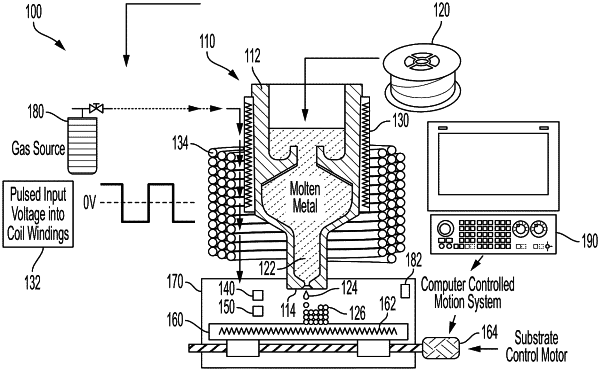| CPC B29C 64/393 (2017.08) [B29C 64/112 (2017.08); B29C 64/209 (2017.08); B33Y 30/00 (2014.12); B33Y 50/02 (2014.12); G06T 7/13 (2017.01); G06T 7/70 (2017.01); G06V 10/255 (2022.01)] | 5 Claims |

|
1. A 3D printer configured to print a 3D object by jetting a plurality of drops of liquid metal of onto a substrate, the 3D printer comprising:
a nozzle configured to jet the drops therethrough at a first frequency, wherein the drops comprise liquid aluminum;
a light source configured to illuminate the drops as the drops descend from the nozzle, wherein the light source emits a plurality of pulses of light at a second frequency, and wherein the first and second frequencies are substantially synchronized such that each pulse of light illuminates one of the drops;
a camera configured to capture a plurality of images of the drops as the drops descend from the nozzle, wherein the images comprise a plurality of light images and a plurality of dark images, wherein the light images are captured while the pulses of light illuminate the drops such that each of the light images includes at least one of the drops that is visible, and wherein the dark images are captured between the pulses of light; and
a computing system configured to:
determine an intensity of each of the images;
select the light images based at least partially upon the intensity, wherein the intensity of the light images is greater than a predetermined intensity threshold, and wherein the intensity of the dark images is less than the predetermined intensity threshold;
detect a plurality of blobs in a first of the light images, wherein a first of the blobs corresponds to a first of the drops;
determine that a second of the blobs does not correspond to the first drop because the second blob is in the same location in the light images, indicating that the second blob is stationary and not descending;
determine that a third of the blobs does not correspond to the first drop because the third blob appears only in a subset of the light images;
determine a first region of interest in the first light image that includes the first blob;
determine a first intensity inside of the first blob and a second intensity outside of the first blob;
determine that the first blob corresponds to the first drop based at partially upon a contrast between the first and second intensities being greater than a predetermined contrast threshold;
determine a second region of interest within the first region of interest, wherein the second region of interest includes the first drop;
perform Canny edge detection, binary closing, and contour detection within the second region of interest to produce a binary mask that corresponds to the first drop;
characterize the first drop by:
determining a size difference between a size of the first drop in the first image and a size of the drops based at least partially upon the binary mask; and
determining a location difference between a location of the first drop in the first image and a location of the drops based at least partially upon the binary mask; and
adjust one or more parameters of the 3D printer based at least partially upon the size difference and the location difference.
|